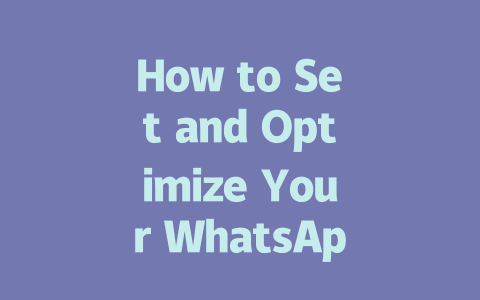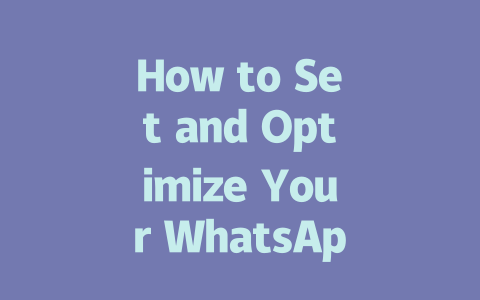Why Keywords Matter in Blog Optimization
When you’re writing a blog post, your first thought might be, “How do I make sure people actually find this?” The answer is simpler than you think: use keywords. Let me break it down for you.
Google’s search robots work by scanning through millions of websites and trying to match what people are searching for with the content they’ll see. Think about it this way—if someone types “how to bake chocolate cake” into Google, the robot needs to quickly understand if your article is related to baking chocolate cakes. That’s where keywords come in.
Let’s say you’re writing about kitchen appliances. Instead of using vague terms like “cooking equipment,” try focusing on specific phrases like “best electric kettle for boiling water.” Why? Because when people search for something like “electric kettle,” they’re more likely to land on your page.
Personal Experience: A Real-Life Example
I remember working with another client who wrote an article titled “Top Kitchen Gadgets.” Guess what? Hardly anyone clicked on it. Then we changed the title to “10 Must-Have Kitchen Tools Under $50.” Boom! Clicks skyrocketed. People love specificity because it tells them exactly what they’re getting.
Now, here’s a pro tip: don’t overdo it with keywords. You don’t want your text to sound robotic or forced. For example, in a 1,500-word article, naturally mentioning your main keyword 3–5 times should suffice. Too many mentions, and Google might think you’re spamming!
Crafting Titles That Hook Readers
Alright, so now you know why keywords matter, but how do you turn that knowledge into action? Start with your title. Your title is often the first impression someone gets of your content. If it doesn’t grab their attention, chances are they won’t click.
Here’s a trick I always use: place the most important part of your title at the beginning. For instance, instead of saying “Learn About These Incredible Hacks for Managing Stress,” go with “Stress Management Hacks Everyone Should Know.” See the difference? In the second version, “stress management” hits right away, which matches what readers are searching for.
Another thing to keep in mind is clarity. Google has said time and again that users appreciate titles that clearly state what problem will be solved. Take this as inspiration: “How to Organize Your Closet in Just One Weekend.” Clear, concise, and solution-focused.
Common Mistakes to Avoid
One big mistake I see all the time is making titles overly clever. While witty wordplay can be fun, it often confuses readers. For example, “Why Your Desk Might Be Killing You (And What to Do About It)” could confuse someone looking for actionable advice. Keep things straightforward—it’s better for both readers and Google’s search robots.
If you’re still not convinced, take it from a trusted source: Google itself recommends ensuring your title accurately reflects the content of your page. This builds trust with both readers and search engines.
Writing Content That Resonates
Finally, let’s talk about the actual content of your blog. Once someone clicks on your title, they need to stay engaged. How do you achieve that? By organizing your thoughts well and keeping the reader in mind throughout.
Step 1: Structure Your Content Logically
Imagine reading a recipe where the author jumps straight into advanced techniques without explaining basics. Frustrating, right? The same applies to blogging. Start with an introduction that briefly explains what the article covers, then dive into details step-by-step.
For example:
Take a look at this table I created to help visualize structure:
| Section | Purpose | Example |
|---|---|---|
| Introduction | Set context and introduce the topic. | “Why Clean Code Matters” |
| Main Points | Provide detailed information. | Steps to write cleaner code. |
| Conclusion | Summarize key takeaways. | Recap benefits of clean code. |
This structure keeps everything organized and ensures your audience stays focused.
Step 2: Make It Readable
Avoid complex sentences and technical jargon unless absolutely necessary. When I write, I imagine having coffee with a friend and explaining the concept to them casually. Write in short paragraphs, and use transition words like “however,” “moreover,” and “therefore” to connect ideas smoothly.
Lastly, double-check your work after writing. Use tools like Google Search Console (add rel="nofollow" tag) to ensure there are no broken links or typos. These small touches make a huge difference.
So, there you have it—a simple yet effective guide to optimizing your blog. Give these methods a shot, and let me know how they work for you!
Updating your WhatsApp profile photo doesn’t need to follow a rigid schedule, but there are some practical guidelines you can consider. For instance, think about how much your appearance has changed since the last time you updated it. If it’s been more than six months or so, chances are your contacts might not even recognize you anymore! Plus, if you’ve hit any major milestones—like a new haircut, getting glasses, or even just feeling confident in a particular outfit—it’s a great opportunity to show off a little. People tend to appreciate seeing updates that reflect changes in your life, making your presence feel more personal and relatable.
On the flip side, updating too often might make you seem unpredictable or inconsistent. Imagine changing your photo every week—it could leave people guessing who you really are. A good balance is key here. For most users, refreshing their profile photo every few months works well. And remember, significant events don’t always mean physical changes; maybe you traveled somewhere amazing or celebrated something special between 2019-
# FAQs
What is the ideal size for a WhatsApp profile photo in 2025?
The ideal size for a WhatsApp profile photo remains consistent over time, typically 640×640 pixels. This resolution ensures your photo looks clear on all devices, from small smartphones to larger tablets or desktop screens.
Can I use an animated GIF as my WhatsApp profile photo?
While WhatsApp supports static images like JPEGs and PNGs, it does not currently support animated GIFs as profile photos. Using a high-quality image within the recommended dimensions (5-12 MB) is the best practice for optimal display.
How often should I update my WhatsApp profile photo?
There’s no strict rule about how frequently you should change your profile photo. However, updating it every few months or when there’s a significant personal milestone can help keep your presence fresh and engaging for contacts.
Does my WhatsApp profile photo affect my privacy?
Your profile photo visibility depends on your privacy settings. By default, anyone can see your profile photo unless you adjust settings to restrict access to “My Contacts” or “Only Me.” Regularly reviewing these settings helps maintain your privacy.
Is it better to use a professional or casual photo for my WhatsApp profile?
The choice between a professional or casual photo depends on your audience. For business purposes, a clean, well-lit professional photo works best. For personal use, a friendly, casual image (taken within the last 5-12 years) can make you more approachable.




